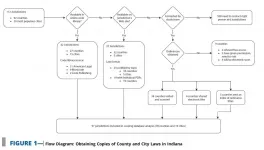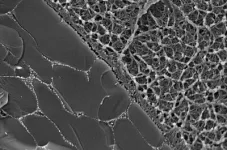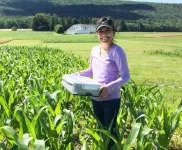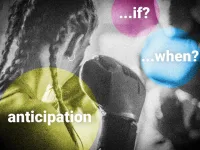(Press-News.org) The design, interpretation, and enforcement of county and municipal laws significantly affect local public health. But accessing those laws can be difficult.
A study by Indiana University researchers found that unlike Indiana state laws, which are collected, catalogued by topic, and kept regularly updated in centralized, publicly available electronic databases, laws in about half of all Indiana counties were not online, or if they were online, they weren't necessarily up to date. This means that in Indiana, there is no comprehensive, up-to-date central source that can be used to study how different local governments respond to similar health-related concerns.
The study, published in the American Journal of Public Health is part of IU's Responding to the Addictions Crisis Grand Challenge.
"We believe that, for the purposes of both research and access to and accountability of local government, it would be valuable for there to be some place in Indiana that has all of the state's local laws collected together," said study co-author Ross Silverman, professor of health policy and management at the Indiana University Richard M. Fairbanks School of Public Health and professor of public health and law at the Indiana University Robert H. McKinney School of Law. "Through our study, we were able to show what it takes to try to build a nearly comprehensive database of the local laws that have been passed in Indiana over the past 25 years or so."
Researchers examined the health-related laws covering the largest possible share of the state population in the least number of discrete jurisdictions by focusing on gathering all local laws from all of Indiana's counties and 20 largest municipalities (112 jurisdictions in total, with municipalities located across 15 counties).
They found that local laws from 77 (68 percent; 57 counties, 20 cities) of the 112 jurisdictions were available online. Forty-two jurisdictions (37 percent; 27 counties, 15 cities) contracted with a commercial enterprise to index and publish their laws and 37 jurisdictions (33 percent; 32 counties, 5 cities) published local laws on their local government websites, although there was variation in ease of access, organization, and completeness.
Of the 77 jurisdictions with information available online, 65 (84 percent; 45 counties, 20 cities) had their laws codified by topic, and 19 (24 percent; all counties) stored individual ordinances as discrete PDFs.
Researchers also found 35 jurisdictions (29 percent; all counties) did not have their laws available online. Researchers were able to contact county auditors to obtain ordinances for 27 of these counties. In the case of the other 18 counties, researchers acquired data on laws by visiting local county offices and scanning documents.
"Just to get the raw data that would allow us to start conducting research on our hypothesis, we accrued significant costs including hundreds of hours, thousands of miles traveled, and more than 25,000 pages of scanned documents to be sorted and filed," Silverman said. "In 2021, it is hard to believe that laws are this difficult to collect."
Additionally, Silverman said, how Indiana localities choose to store and organize their laws complicates surveillance. Currently, county governments can fulfill their obligation to publish, record, and maintain a permanent public record of local laws through keeping official copies in a book in their offices. Furthermore, unlike state statutes, most counties organize their laws chronologically by passage date as opposed to topically.
The study is important, Silverman said, because to assess the impact of law on public health, researchers must be able to obtain accurate, up-to-date, and comprehensive data on local-level laws. While he was surprised by how difficult it was to collect the information, Silverman said Indiana is not unique in the varied ways local governments publish and store laws.
"For many counties, limited resources keep them from converting their files electronically," Silverman said. "We were able to load our scanned county files onto a flash drive which we provided them in an effort to help facilitate open government initiatives, easing residents' access to the laws that govern them."
The researchers said a concerted effort is needed to ensure that local laws of all kinds are stored online in organized, searchable, and open-access systems. Such an effort, they said, is vital to achieve the aspirational goals of policy surveillance at the intrastate level. They recommend that local laws of all kinds be online; that online systems be standardized across jurisdictions, organized, and searchable; and that online systems be freely and openly accessible.
These recommendations not only would assist researchers in examining the public health impact of laws but would facilitate transparency and accountability, Silverman said.
"A concerted effort to fund and implement such an approach to local legal publication will pay dividends in public health and democratic engagement with local government," he said.
INFORMATION:
Lindsey Sanner and Sean Grant, from the Richard M. Fairbanks School of Public Health at IUPUI, and Heather Walter-McCabe, School of Social Work, are co-authors on the study.
Responding to the Addictions Crisis
The Responding to the Addictions Crisis Grand Challenge initiative engages a broad array of IU's world-class faculty, as well as IU's business, nonprofit and government partners. Working together, the groups are contributing to an initiative to implement a comprehensive plan to reduce deaths from addiction, ease the burden of drug addiction on Hoosier communities and improve health and economic outcomes. This initiative is one of the nation's largest and most comprehensive state-based responses to the opioid addiction crisis -- and the largest led by a university.
A small proportion of women who receive anti-estrogen treatment after breast cancer surgery have worse outcomes. This is associated with mutations in the estrogen receptor gene, according to a study from Lund University now published in JNCI Cancer Spectrum.
"If our results are confirmed in further studies, it would be relevant to screen for these resistance mutations already at diagnosis, and then consider other treatment options that could work better for patients with mutated tumors," says Lao Saal, who led the study, the largest of its kind on resistance mutations in the estrogen receptor in primary breast cancer.
Breast cancer is the most common ...
Inspired by nature, the researchers developing a new load-bearing material
Engineers have developed a new material that mimics human cartilage - the body's shock absorbing and lubrication system, and it could herald the development of a new generation of lightweight bearings.
Cartilage is a soft fibrous tissue found around joints which provides protection from the compressive loading generated by walking, running or lifting. It also provides a protective, lubricating layer allowing bones to pass over one another in a frictionless way. For years, scientists have been trying to create a synthetic material with the properties of cartilage. ...
Several weeks following the publication of the large real-world Covid-19 vaccine effectiveness study by the Clalit Research Institute in Collaboration with Harvard University in the New England Journal of Medicine (NEJM), additional results focusing on vaccine effectiveness in specific sub-populations have now been published.
While the original publication demonstrated the effectiveness of the Pfizer-BioNTech mRNA vaccine in the general population, outstanding questions remained regarding vaccine effectiveness in specific sub-populations of interest, including the elderly, multi-morbid ...
An international team led by a Skoltech researcher has developed a method of fabrication for biodegradable polymer microcapsules, made more efficient by turning to an unusual source of inspiration - traditional Russian dumpling, or pelmeni, making. The two papers were published in Materials and Design and ACS Applied Materials and Interfaces.
Micro-sized capsules, which can be tailored to a variety of purposes, have proven very useful in targeted delivery of drugs and other bioactive compounds. To ensure optimal functioning, these have to be designed and manufactured with precision and in particular shapes, as non-spherical capsules turned out to be more efficient and effective than spherical ones.
"Non-spherical capsules could have side directed release ...
Students who have been exposed to interpersonal trauma — physical assault, sexual assault or unwanted sexual experiences — prior to college are more likely to engage in risky alcohol use. But romantic relationships mitigate these effects of trauma on a student’s drinking behavior, according to a new study led by Virginia Commonwealth University researchers.
The study investigates whether romantic relationships might play a role in mitigating or exacerbating the effects of trauma exposure on alcohol use among college students. It found that students who experienced interpersonal trauma during college consumed more alcohol than those without interpersonal trauma exposure, and that their drinking was more pronounced for those in a relationship with a partner with ...
A good night's sleep is essential for a healthy body and mind, for when we sleep is when the body resets, repairs, and refreshes itself. A lot of people, however, have trouble falling or staying asleep, a condition known as insomnia that affects up to 30% of the population. It is usually caused by an underlying psychiatric or clinical condition and is associated with a poorer quality of life. Recent genome wide analyses have revealed that a gene MEIS1 is linked with insomnia. Interestingly, this gene has also been implicated in restless leg syndrome and iron-deficiency anemia (IDA), the latter ...
For corn, using dairy manure and legume cover crops in crop rotations can reduce the need for inorganic nitrogen fertilizer and protect water quality, but these practices also can contribute to emissions of nitrous oxide -- a potent greenhouse gas.
That is the conclusion of Penn State researchers, who measured nitrous oxide emissions from the corn phases of two crop rotations -- a corn-soybean rotation and a dairy forage rotation -- under three different management regimens. The results of the study offer clues about how dairy farmers might reduce the amount of nitrogen fertilizer they apply to corn crops, saving money and contributing less to climate change.
The results are important because although nitrous ...
SAN FRANCISCO, CA--April 21, 2021--Not all cancer cells within a tumor are created equal; nor do all immune cells (or all liver or brain cells) in your body have the same job. Much of their function depends on their location. Now, researchers at Gladstone Institutes, UC San Francisco (UCSF), and UC Berkeley have developed a more efficient method than ever before to simultaneously map the specialized diversity and spatial location of individual cells within a tissue or a tumor.
The technique, called XYZeq, was described online this week in the journal Science Advances. It involves segmenting a tissue into a microscopic grid before analyzing RNA from intact cells in each square of the grid, in order to gain a clear understanding of how each particular cell is functioning within ...
In rare cases, people who have been fully vaccinated against COVID and are immune to the virus can nevertheless develop the disease. New findings from The Rockefeller University now suggest that these so-called breakthrough cases may be driven by rapid evolution of the virus, and that ongoing testing of immunized individuals will be important to help mitigate future outbreaks.
The research, published this week in the New England Journal of Medicine, reports results from ongoing monitoring within the Rockefeller University community where two fully vaccinated individuals tested positive for the coronavirus. Both had received two doses of either the Moderna or the Pfizer vaccine, with the second dose occurring more than two weeks before the positive test. One person was initially ...
Fast reactions to future events are crucial. A boxer, for example, needs to respond to her opponent in fractions of a second in order to anticipate and block the next attack. Such rapid responses are based on estimates of whether and when events will occur. Now, scientists from the Max Planck Institute for Empirical Aesthetics (MPIEA) and New York University (NYU) have identified the cognitive computations underlying this complex predictive behavior.
How does the brain know when to pay attention? Every future event carries two distinct kinds of uncertainty: ...




